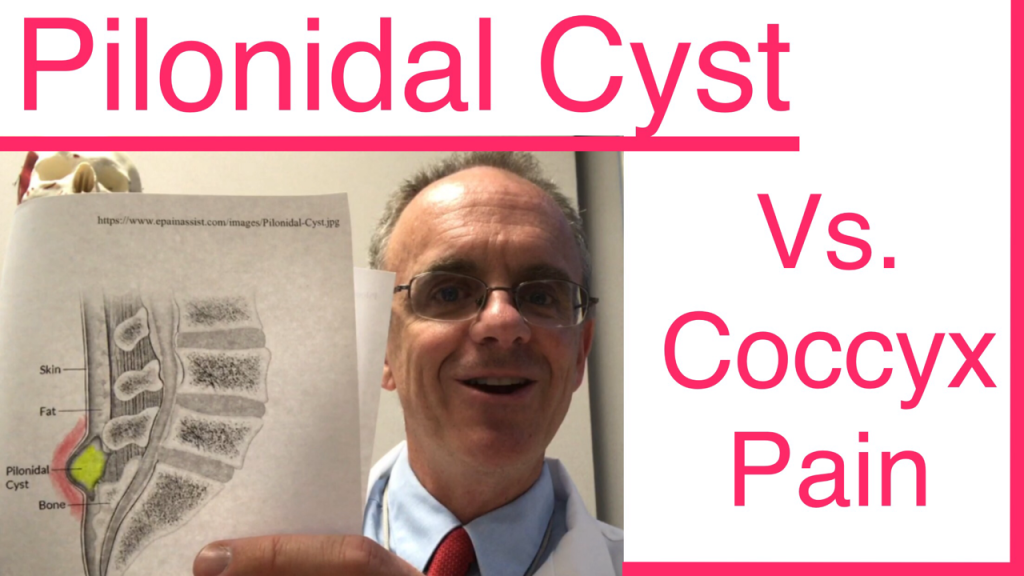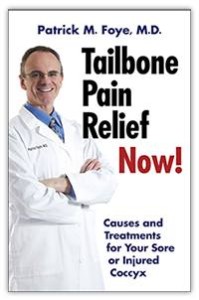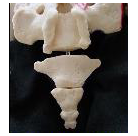Sometimes, Coccyx Pain (Tailbone Pain) can be Caused by a Pilonidal Cyst…
- A “cyst” is a collection of fluid. Think of it being like a tiny water balloon.
- A pilonidal cyst is a particular type of cyst that contains not only fluid but also hair and other debris.
- The most common location for a pilonidal cyst is within the skin behind the sacral or coccyx.
- A pilonidal cyst can cause local pain and tenderness.
- As the fluid from the cyst tries to escape from thus cyst, it creates a tunnel. The tunnel is referred to as a track. When that track reaches the skin you can see a tiny hole in the skin. This is a fistula tract.
- As fluid oozes out of the fistula tract, the patient may have a rash, redness, and itching of the skin in that area.
- As the fluid oozes out, there is now less fluid within the cyst, so the pain and pressure from the cyst may decrease.
- However, the fluid and pressure within the cyst may start to increase again, resulting in the pain coming back or increasing.
How Do You Tell the Difference between Pain Coming from a Pilonidal Cyst Versus Pain Coming from the Tailbone?
- Usually, a physician with experience will be able to tell whether someone’s pain is coming from a pilonidal cyst or if the pain is coming from the coccyx (tailbone).
- BOTH the tailbone and the cyst can cause local pain,, and pain that is worse with sitting.
- However, the symptoms of a cyst are different than coccydynia if the cyst has started oozing to the surface, since the patient may feel the fluid wetness, along with itchiness, and may notice redness or rash on the skin in the area.
- On physical exam, the physician should look directly at the skin over the involved area, specifically looking for the following signs of a pilonidal cyst:
- a small hole (fistula) in the skin
- redness of the skin
- rash of the skin
- wetness/dampness of the skin
- On physical exam, the doctor can press carefully over the coccyx (tailbone) and over the nearby areas, to assess whether the tenderness is over the bones of the coccyx versus over the nearby soft tissues.
- In some cases, medical imaging studies may be helpful and even necessary.
- X-rays can show abnormalities of the coccyx, including fractures, dislocations, arthritis, bone spurs, etc..
- X-rays generally will NOT show the pilonidal cyst.
- MRI can show BOTH the coccyx AND the pilonidal cyst.
- Unfortunately, medical imaging studies in the tailbone region frequently are NOT done correctly. They often fail to include the proper specific images that would be needed to assess the tailbone region. This is unfortunately true for x-rays, MRI, and CT scans. The ordering physician needs to be extremely clear in how they order the imaging studies, and the patient should encourage the radiology technician to make sure that the involved area is included and properly seen.
- Click here for a separate article and video on MRI revealing a Pilonidal Cyst at the Tailbone.
The Video below explains how to tell if pain is due to a pilonidal cyst versus due to coccyx problems.
- To watch the video, click on the image, or click on the Link below:

- Link: https://youtu.be/KOdIY5jXjZg
Here is the text from the video:
- Hi, I’m Dr. Patrick Foye and I’m an M.D., or medical doctor, and I’m a medical school Professor and also the Founder and Director of the Coccyx Pain Center or Tailbone Pain Center here in the United States.
- You can find me online at www.TailboneDoctor.com.
- And this is really going to be just a short discussion about a pilonidal cyst and how you tell the difference between whether somebody has tailbone pain (or coccyx pain, coccydynia, pain that is coming from the tailbone itself) and distinguishing that from somebody who may have pain coming from a pilonidal cyst.
- So first of all what are the things that they have in common? Well a few things.
- Both of them are painful: a pilonidal cyst is painful and coccydynia is painful.
- Number two: where they’re located.
- Both of them tend to occur in the coccyx area, which is here at the lower end of the spine.
- So slightly above the anus, kind of at the back of the pelvis.
- The lower tip of the spine is the tailbone or coccyx.
- Pilonidal cysts tend to occur at the back of the sacrum and coccyx.
- So the area is generally very similar for both pilonidal cysts and for coccydynia.
- The other thing that they have in common is that both of them not only are painful but they can happen after a sudden trauma, but they can also happen without trauma.
- So that doesn’t help us to to tell the difference between the two.
- So both of them have pain, pain with sitting, with or without trauma, the location.
- All of that is very similar between the two.
- So then how can you tell the difference? The main thing is that a pilonidal cyst is different because it’s not down at the bony level the way that the coccyx is.
- So, again, for the tailbone or coccyx we’re talking about bone pain down at the coccyx itself and tenderness when you press typically onto the bone itself.
- Whereas a pilonidal cyst, as I’ll show you in the illustration, here is not down at the bone.
- It’s basically in the soft tissue structure.
- So you can see this swelling here.
- So often with a pilonidal cyst number one is that they’re not tender directly on the bone.
- Number two is that they may feel this lump or bulge because they have this collection of fluid a cyst is just a bag of fluid think about like a tiny water balloon just beneath the skin there.
- So that is the nature of a cyst (shown in yellow on the illustration here).
- And basically as that fluid starts to collect you get a lot of irritation you may get redness of the skin over the area so it starts to look something like that.
- And the other thing is that the cyst can start to try to find its way out.
- So the fluid and the pressure will start to build up and then the fluid starts to tunnel its way out towards the edge of the skin.
- And then at the skin you may see a little bit of a pimple over the area and it may burst open.
- And when it bursts open it oozes or lets out all of that gunk, that junk, that’s in there (all of that debris).
- What’s in there? Well there’s fluid as we mentioned.
- Often there’s debris like bits of hair can be in there as well.
- In fact, “pilonidal” means “nest of hair”. That’s the medical term.
- But basically all of that stuff starts to ooze out and when it does it’s really irritating to the skin.
- So again you’ll get more redness on the skin from a pilonidal cyst.
- You’ll get itching of the skin.
- You may get a rash of the skin just from being exposed to all of that stuff.
- And it may start to smell badly as well, especially if this is infected, in which case it’s not just a pilonidal “cyst” it’s a pilonidal “abscess” (an actual infection in the area) Those are the things about a pilonidal cyst.
- But with tailbone pain (coccyx pain) typically you don’t feel a substantial lump, you don’t get the redness on the skin usually, you don’t get the rash and the itching.
- Those are not typical for musculoskeletal, mechanical, coccyx pain or tailbone pain.
- Other things that are different: the treatments are very different.
- For treatment of tailbone pain (coccydynia) I have a whole aisle whole book you can get on Amazon.com or at www.TailbonePainBook.com There’s 272 pages in here all about workup and treatment for a tailbone pain.
- So that’s a lot, and I have a lot of videos and things online already about tailbone pain.
- But within the book I think I have maybe just two sentences or so about pilonidal cysts in the area, just to keep a lookout for them.
- So really the reason I’m doing this video is to add some additional info.
- I do not treat pilonidal cysts directly, so if you have a pilonidal cyst don’t make the the long trip to come and see me the way that many people do for tailbone pain.
- See your local primary care physician or perhaps a a local general surgeon.
- Usually they will be able to treat a pilonidal cyst very very well.
- The treatment really depends.
- If it’s mild sometimes just a soaking in a warm bath that or putting warm compresses can help that to ease some of that pressure or get rid of out some of that junk.
- If it’s really problematic one of the things you’ll want to do is certainly when you’re in consultation with your physician see about whether it makes sense to actually cut it open: “incision and drainage” there’s different techniques marsupialization, etc.
- There’s ways to cut it open and drain that junk out of there.
- So that hopefully not only do you relieve the pressure and get it out but that it does not come back.
- Because sometimes, with a pilonidal cyst, the fluid can come back and build up again.
- So the treatment then is really typically a relatively minor outpatient surgery to have that area opened up for a pilonidal cyst.
- If it’s infected then it’s a pilonidal abscess so things get a little more involved and certainly antibiotic treatment becomes important.
- So anyway that’s a couple of minutes just talking about what is a pilonidal cyst and how is it different from coccyx pain or tailbone pain.
- So that if you have a pilonidal cyst you should be treated or evaluated for a pilonidal cyst.
- And if you have a tailbone problem you should be treated or evaluated by someone with expertise in treating tailbone problems.
- If you want more information certainly you can find me online at www.TailboneDoctor.com Or certainly, you can get a copy of the book: there’s an e-book that you can get on Amazon.
- You can also get the hardcopy book on Amazon.
- At the time that I’m making this video, I’m actually giving away the hard copy of the book for free you just pay for shipping and handling.
- Only in the United States that’s printed paper book is available and for that you would get it through www.TailboneBook.com.
- So lots of ways for you to get information.
- I’m a big believer in empowering patients to learn as much as you can about your medical conditions so that in consultation with your treating physicians you can make the best decisions possible in your medical care.
- So that’s all for now I hope that was helpful for you.
- If you have questions or thoughts on this topic certainly post them down below and I look forward to reading them.
To come to Dr. Foye’s Tailbone Pain Center:
- Get expert medical care for your tailbone problem. Here’s what you need know: https://tailbonedoctor.com/prepare-for-your-visit/
Tailbone Pain Book:
To get your copy of Dr. Foye’s book, “Tailbone Pain Relief Now!” click on this link: www.TailbonePainBook.com

Book: “Tailbone Pain Relief Now! Causes and Treatments for Your Sore or Injured Coccyx” by Patrick Foye, M.D.
Latest posts by Patrick Foye, M.D. (see all)
- Coccygectomy: Expected Recovery and Return to Work after surgery for coccyx pain, tailbone pain. - November 28, 2023
- PRP Platelet Rich Plasma or Prolotherapy for Tailbone Pain, Coccyx Pain - October 25, 2023
- Reasons for Normal X-rays and MRI Despite Tailbone Pain, Coccyx Pain - October 3, 2023

